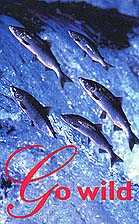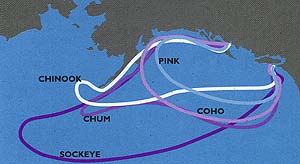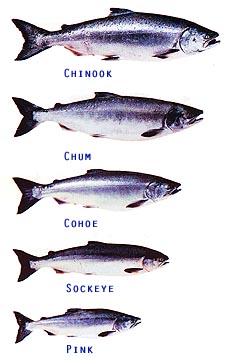
Our
Our
Home | Info
Copyright 1998-2003
![]()
Italiano
fish products:
Salmon
Tuna
Ventresca
Mackerel
Anchovies
Herring
Sardines
Cod
Stockfish
Blue fish
Shrimp
Crab
Scallops
vegetable products:
Green olives
Black olives
Asparagus
Palmitos
Recipes | Products
Company | E-mail
Stella Alimentari
Foods Import Since 1935
Via Ticino 54
20098 San Giuliano Mil. Italy
Ph. + 39.02.98284304
Fax + 39.02.9881001
Email: stella@stellafoods.com
http://www.stellafoods.com
|
Salmon biology
It is still a mistery exactly how salmon find their way home but they seem to rely on a combination of genetic coding, celestial navigation, electromagnetic currents, and a strong sense of smell.. Each spawning population from a different stream is a separate stock (a term frequently used by biologists and fisheries managers) so any one species may consist of a thousand or more stocks. On the Fraser River, the largest salmon river in the world, sockeye are managed according to four main stock groupings: Early Stuart, Early Summer, Summer e Late. The survival of a particular stock depends on many factors, but an essential one is preservation of the spawning grounds. If, for example, the gravel bars where a particular cohoe stock spawns are destroyed by storms or logging, then the returning adults will have nowhere to lay their eggs, the stock will be unable to reproduce and will eventually disappear. Wild salmon species Chinook. Also called spring or king salmon, the largest of British Columbia's salmon often running over 35 lbs (18 kg) is much sought after by sports fishermen. Prized by gourmets, its firm flesh can range from ivory white to deep red. Commercial harvests are small.
Chum. Sometimes known as "dog" salmon from the big teeth this species develops at spawning time, it is known as keta when canned. The flesh ranges from pale to medium red and is especially low in saturated fat. In the supermarket, chum offers especially good value for the money. Cohoe. Also popular with sports fishermen, cohoe is a favourite choice in season in supermarkets, fish stores and restaurants fr its good red colour, moderate price, and its versatility. Sockeye is the mainstay of the commercial fishery, contributing about two-thirds of the total value of the salmon harvest. Its deep-red, firm flesh makes it the richiest and most sought-after of British Columbia's salmon and gives it the name of red salmon when canned. Pink is the smallest and most abundant of the Pacific species, often known as a "humpy" from the hump it develops on its back at spawning time. The flesh is light in colour and delicately flavoured. Three quarters of the harvest is canned; the rest is sold fresh or frozen in supermarkets, often at attractive prices. |
 Salmon isn't simply a salmon. Five species of salmon are native to the North Pacific, in the British Columbia region and biologists have recently reclassified steelhead making it a sixth species. Each species has a different life cycle ranging anywhere from two to six or seven years, but all are born in fresh water, migrate downriver to the cold open waters of the ocean, often travelling thousands of kilometers, and then miraculously return to the river of their birth.
Salmon isn't simply a salmon. Five species of salmon are native to the North Pacific, in the British Columbia region and biologists have recently reclassified steelhead making it a sixth species. Each species has a different life cycle ranging anywhere from two to six or seven years, but all are born in fresh water, migrate downriver to the cold open waters of the ocean, often travelling thousands of kilometers, and then miraculously return to the river of their birth.
